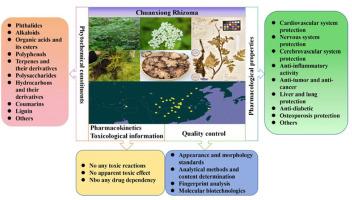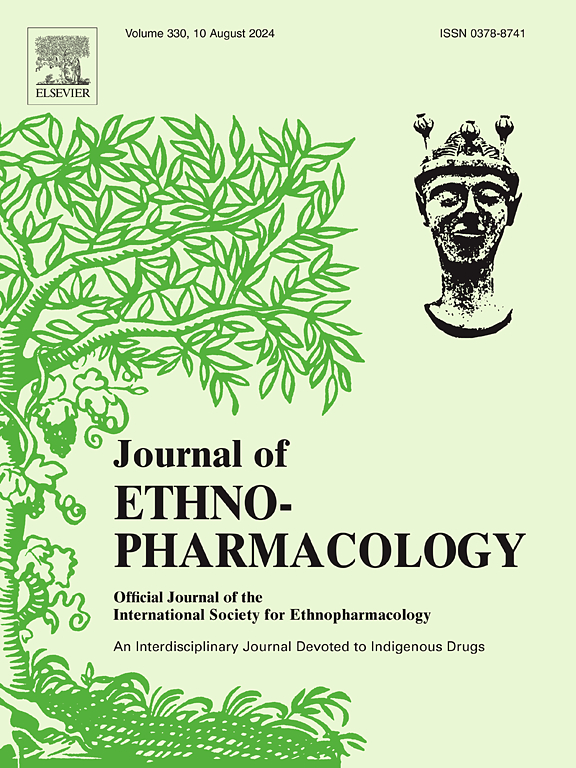Ethnobotanical usages, phytochemistry, pharmacology, and quality control of chuanxiong rhizoma: A review
IF 4.8
2区 医学
Q1 CHEMISTRY, MEDICINAL
引用次数: 0
Abstract
Ethnopharmacologic relevance
Chuanxiong Rhizoma (CX) is the dried root rhizomes of the plant Ligusticum chuanxiong Hort. of the family Umbelliferae. CX is listed as a superior herb in the book “Shennong Bencao Jing". It has a pungent and warm nature and belongs to the liver, gallbladder, and pericardium meridians. CX is documented in the Chinese Pharmacopoeia from 1963 to 2020 editions. CX as a well-known traditional Chinese medicine for promoting blood circulation, regulating qi, dispelling wind, and relieving pain, has been proven to contain a variety of bioactive compounds with diverse pharmacological activities and medicinal value.
Aim of the study
The current review aims to provide a comprehensive analysis of the botany, traditional uses, phytochemistry, pharmacology, toxicity, quality control and pharmacokinetics of CX.
Materials and methods
The relevant information of CX was obtained from several databases including Web of Science, PubMed, ACS Publications, Google Scholar, Baidu Scholar, CNKI, Ph.D, MSc dissertations, as well as The Catalogue of Life, Flora of China database, and The Global Biodiversity Information Facility.
Results
CX is widely used in traditional medicine for treating various diseases related to the cardiovascular system, liver and kidney system, nervous system, respiratory system, and more. Over 400 compounds have been identified in CX, including phthalides, alkaloids, organic acids and its esters, polyphenols, terpenes and their derivatives, polysaccharides, hydrocarbons and their derivatives, coumarins, lignans and others. The plant extracts, compounds and Chinese patent medicines possess various pharmacological activities, including cardiovascular system protection, nervous system protection, cerebrovascular system protection, anti-inflammatory, liver and lung protection, anti-diabetes, anti-osteoporosis, anti-bacterial, anti-aging, anti-oxidant, immune regulation, prevention of DNA damage, prevention of postoperative peritoneal adhesion.
Conclusion
Considering its traditional and modern applications, phytochemical composition, and pharmacological properties, CX can be regarded as a traditional Chinese medicine resource for treating various diseases related to the cardiovascular, hepatorenal, nervous, and respiratory systems. Current research mainly focuses on cell and animal experiments, where some active ingredients exhibit diverse pharmacological activities. However, further studies are needed to fully understand its specific mechanisms of action. In addition, there are multiple active ingredients in CX, but current research mainly focuses on the pharmacological effects of individual components, with little research on the interactions and synergistic effects between different components. It is recommended to strengthen the research on the interactions of CX compounds and their components to reveal the overall pharmacological mechanisms. This will contribute to quality control, new drug development, commercialization, and promote its continuous development in the field of medicine.

川芎的民族植物学用途、植物化学、药理学和质量控制:综述。
民族药理学意义:川芎是伞形科植物川芎的干燥根茎。川芎在《神农本草经》中被列为上品药材。其性辛温,归肝、胆、心包经。从 1963 年至 2020 年版的《中国药典》中均有记载。作为一种著名的活血、理气、祛风、止痛的中药,中药已被证实含有多种生物活性化合物,具有不同的药理活性和药用价值:本综述旨在全面分析 CX 的植物学、传统用途、植物化学、药理学、毒性、质量控制和药代动力学:从多个数据库中获取了 CX 的相关信息,包括 Web of Science、PubMed、ACS Publications、Google Scholar、百度学者、CNKI、博士、硕士论文以及《生命目录》、中国植物志数据库和全球生物多样性信息基金:在传统医学中,CX 被广泛用于治疗与心血管系统、肝肾系统、神经系统、呼吸系统等有关的各种疾病。已在 CX 中鉴定出 400 多种化合物,包括邻苯二甲酸盐、生物碱、有机酸及其酯类、多酚类、萜类及其衍生物、多糖、碳氢化合物及其衍生物、香豆素、木脂素等。植物提取物、化合物和中成药具有多种药理活性,包括心血管系统保护、神经系统保护、脑血管系统保护、抗炎、保肝、保肺、抗糖尿病、抗骨质疏松、抗菌、抗衰老、抗氧化、免疫调节、防止 DNA 损伤、防止术后腹膜粘连等:考虑到其传统和现代应用、植物化学成分和药理特性,CX 可被视为治疗与心血管、肝肾、神经和呼吸系统有关的各种疾病的传统中药资源。目前的研究主要集中在细胞和动物实验方面,其中一些有效成分表现出多种药理活性。然而,要充分了解其具体的作用机制,还需要进一步的研究。此外,CX 中含有多种有效成分,但目前的研究主要集中在单个成分的药理作用上,对不同成分之间的相互作用和协同效应研究较少。建议加强对 CX 复合物及其成分相互作用的研究,以揭示整体药理机制。这将有助于质量控制、新药开发和商业化,并促进其在医药领域的不断发展。
本文章由计算机程序翻译,如有差异,请以英文原文为准。
求助全文
约1分钟内获得全文
求助全文
来源期刊

Journal of ethnopharmacology
医学-全科医学与补充医学
CiteScore
10.30
自引率
5.60%
发文量
967
审稿时长
77 days
期刊介绍:
The Journal of Ethnopharmacology is dedicated to the exchange of information and understandings about people''s use of plants, fungi, animals, microorganisms and minerals and their biological and pharmacological effects based on the principles established through international conventions. Early people confronted with illness and disease, discovered a wealth of useful therapeutic agents in the plant and animal kingdoms. The empirical knowledge of these medicinal substances and their toxic potential was passed on by oral tradition and sometimes recorded in herbals and other texts on materia medica. Many valuable drugs of today (e.g., atropine, ephedrine, tubocurarine, digoxin, reserpine) came into use through the study of indigenous remedies. Chemists continue to use plant-derived drugs (e.g., morphine, taxol, physostigmine, quinidine, emetine) as prototypes in their attempts to develop more effective and less toxic medicinals.
 求助内容:
求助内容: 应助结果提醒方式:
应助结果提醒方式:


